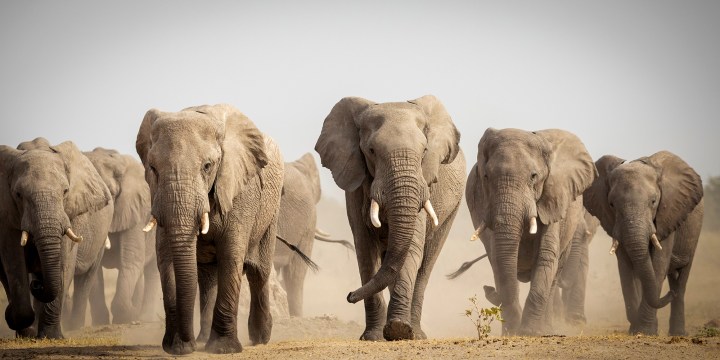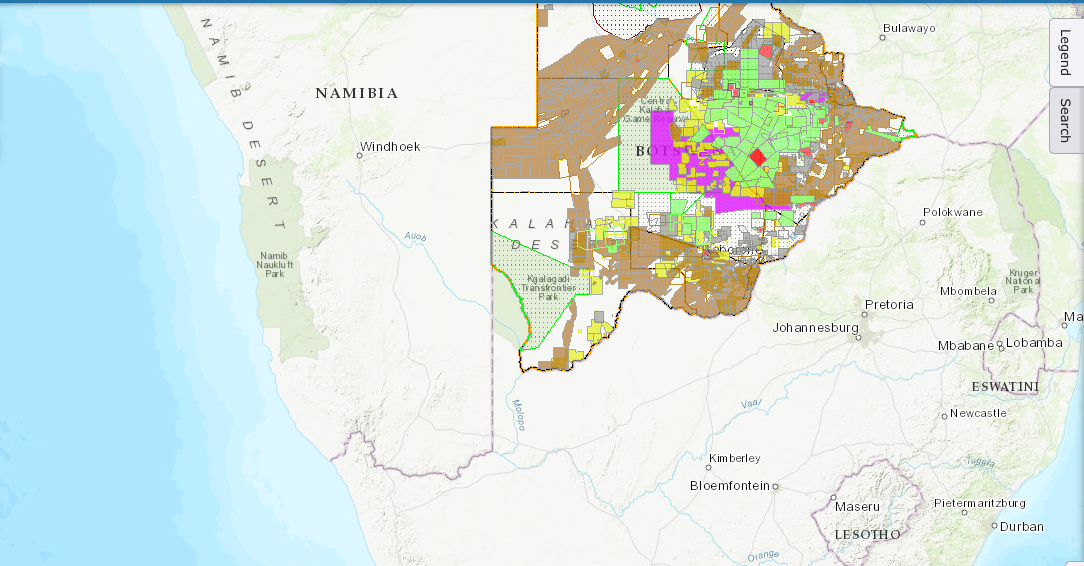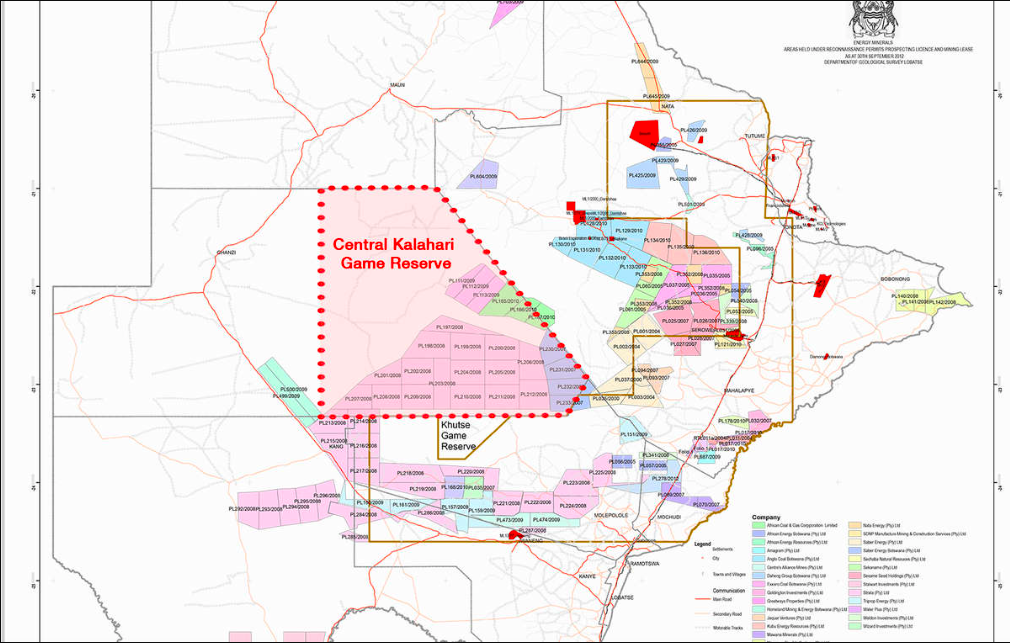Business Maverick
Botswana’s mining cadastre reveals hydrocarbon scramble in iconic Kalahari game reserve

There is a scramble for oil, gas and coal in Botswana, much of it centred on the Central Kalahari Game Reserve (CKGR). After a flurry of reports about alleged fracking plans in the park several years ago, this drive has been underreported recently, with attention diverted to such activities elsewhere in the country.
The world’s second largest reserve, the remote CKGR is home to a plethora of African flora and fauna including the Big 5, and is a sacred ancestral homeland of the San Bushmen whose forced removal from the park, ostensibly for conservation purposes, has been widely documented.
DM168 can reveal that about half the surface area of the 52,800 square- kilometres park — about two and a half times the size of the Kruger National Park — has been allotted into blocks for exploration for oil, gas, coal, coalbed methane, and other minerals and metals.
This raises obvious environmental concerns as well as questions about funding sources for such projects in an age when the green energy transition is in full swing and bankers are increasingly reluctant to fund fossil fuel initiatives, notably for coal. Investors are also wary of sinking capital into projects that can potentially threaten wildlife, and African animals in particular press buttons.
But the Botswana government cannot be accused of granting such licences on the sly. It’s all there, plain as day, on the country’s mining cadastre, which recently went live.
A mining cadastre is an online portal that allows the public access to view existing mining rights, exploration permits and related things.
Botswana’s map is colour-coded, with various shades denoting exploration and prospecting licences, active operations, pending applications and so on. When you click on a coloured area, you find the company holding the licence, when it was granted and expires, its purpose, and so on.
It’s all refreshingly revealing.
For starters, a little-known company called Pelkbuck was awarded an exploration licence for natural gas and petroleum on 1 October 2021 over a series of blocks amounting to almost 45,000 square kilometres, most of them in the CKGR.

The cadastre portal.
DM168 could not find a website for Pelkbuck, and the scant references to an oil and gas exploration services by that name show a privately-held entity based in the British Virgin Islands, a tax haven. This does not mean the company is dubious; it just raises red flags around transparency.

A leaked 2013 map covers much of the same ground as the current cadastre, though there are differences.
A company called Equitorial Oil and Gas — the curious spelling is what the cadastre shows — has a prospecting licence for coal and coalbed methane in the park, and another one that has been suspended. The Botswana government’s official Daily News did announce in August 2020 that Equitorial Oil and Gas (that spelling again) had been issued with a petroleum exploration licence, without specifying where at the time.
Alloys and Minerals Botswana has one for coal and coalbed methane in the park covering 954 square kilometres. Coalbed methane is a natural gas extracted from coal beds and is a source of greenhouse gas emissions (CGE). There is an abundance of it under the sands of the Kalahari.
Various other small companies also have prospecting or exploration permits in the park — the total is over two dozen. Not all are for hydrocarbons. Some are for other valuable commodities including diamonds and it is widely known that Gem Diamonds is currently operating the Ghaghoo diamond mine in the park.
But the precise nature and scale of hydrocarbon exploration in the park was poorly known until the government’s cadastre went live, bringing instant transparency.
There has been reporting in the past focused on apparent plans for fracking in the CKGR. The UK Guardian and a documentary film in 2013 The High Cost of Cheap Gas reported the government had granted half of the CKGR to concessions for fracking.
A leaked 2013 map covers much of the same ground as the current cadastre, though there are differences. For example, the 2013 map extended to the reserve’s southwest corner, while the cadastre shows no hydrocarbon exploration whatsoever in that area now.
There is a prospecting licence for diamonds in a slither of the southwest corner issued to Diamexstrat Botswana, a subsidiary of Diamond Exploration Strategies, a private UK-registered company.
Another difference with the leaked map from a decade ago is the park’s northwest corner. The 2013 map showed no exploration there, but the cadastre highlights a number of current prospecting licences for a wide range of commodities including chrome, gold, lithium, manganese, palladium, platinum and cobalt.
Australia and AIM-listed Tlou Energy Resources has prospecting licenses for coal and coalbed methane near the park’s southeast boundary, but not inside the conservation area, the cadastre shows.
One company with a huge Botswana presence notably absent in the CKGR, according to the cadastre, is diamond giant De Beers. It has a prospecting licence for diamonds near the southeast corner of the reserve but not within its boundaries. Diamond mining has long been the cornerstone of the Botswana economy and its coveted investment-grade credit rating.
De Beers operates in the country through a joint-venture with the Botswana government called Debswana. It is also a unit of Anglo American, which is at pains to burnish its ESG — environmental, social and governance — credentials, and would likely face shareholder and public blowback to any intrusion into an African game reserve of such significance.
There were also reports in 2015 that the Botswana government had sold rights for shale gas fracking over a swathe of the Kgalagadi Transfrontier that includes South Africa — reports denied by the government.
The cadastre indicates there is no hydrocarbon exploration or prospecting activity currently in the park, including pending applications.
However, Kavango Minerals — a unit of LSE-listed Kavango resources — has a prospecting licence on a tiny block of 390 square kilometres inside the park’s eastern rim for a range of metals and minerals including copper, gold, cobalt, manganese and platinum group metals.
The cadastre also shows that the main body of the Okavango Delta has no activity linked to extractive industries, nor the Chobe National Park in northern Botswana which boasts the world’s largest concentration of elephants, with numbers estimated at around 120,000.
Much of the recent media coverage on hydrocarbon exploration in Botswana has highlighted ReconAfrica, a publicly-listed Canadian company exploring in Botswana’s northwest corner and northeastern Namibia.
Its exploration licence is clearly denoted on the cadastre, and alarm bells have been ringing as its permits straddling the border overlap the ecologically sensitive Kavango-Zambezi Transfrontier Conservation Area upstream from the Okavango Delta.
A recent report by amaBhungane said investors were upset by the company’s failure to disclose facts that undermined the project’s viability such as Namibia’s no-fracking policy.
The cadastre also demonstrates that the area is a hive of activity for prospecting for uranium and other valuable metals and minerals including PGMs, nickel, copper, cobalt and others.
It all raises a number of questions. Many of the metals in Botswana that geologists are looking for such as copper, cobalt and lithium are regarded as “green” and seen as crucial to the switch from fossil fuels.
On a global scale, many of these metals are found in, and are sure to be uncovered, in areas of ecological importance and fragility, taking some of the “green” sheen off the transition.
The search for hydrocarbons in Botswana is more problematic. Coal mining among other things is water intensive, and arid Botswana is not famed for its water abundance, outside some ecologically crucial areas marked by seasonal ebbs and flows.
One suspects that raising finance on this front will not be easy, while the long-term viability of such projects is in question as the global economy moves beyond fossil fuels. This raises a huge risk of such assets becoming stranded in the dunes. Even vultures will not flock to such carcases.
But the age of “leaked maps” and opaque plans appears to be over. Expect Gaborone to take condemnation from conservationists over opening the CKGR to hydrocarbon and other kinds of resource exploration and possible extraction. Yet it cannot be faulted for trying to conceal its spoor in the sand. Unlike South Africa, which has yet to acquire a functional cadastre, this scramble in Botswana is in full public view. DM168



















 Become an Insider
Become an Insider
So no lessons from the past learnt it seems! Those with San heredity need to stake their claims fast!
Who will ensure The San know about it?